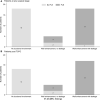Intrahepatic Dynamic Contrast-Enhanced Magnetic Resonance Lymphangiography: Potential Imaging Signature for Protein-Losing Enteropathy in Congenital Heart Disease
- PMID: 34569246
- PMCID: PMC8649156
- DOI: 10.1161/JAHA.121.021542
Intrahepatic Dynamic Contrast-Enhanced Magnetic Resonance Lymphangiography: Potential Imaging Signature for Protein-Losing Enteropathy in Congenital Heart Disease
Abstract
Background Protein-losing enteropathy (PLE) is a significant cause of morbidity and mortality in congenital heart disease patients with single ventricle physiology. Intrahepatic dynamic contrast-enhanced magnetic resonance lymphangiography (IH-DCMRL) is a novel diagnostic technique that may be useful in characterizing pathologic abdominal lymphatic flow in the congenital heart disease population and in diagnosing PLE. The objective of this study was to characterize differences in IH-DCMRL findings in patients with single ventricle congenital heart disease with and without PLE. Methods and Results This was a single-center retrospective study of IH-DCMRL findings and clinical data in 41 consecutive patients, 20 with PLE and 21 without PLE, with single ventricle physiology referred for lymphatic evaluation. There were 3 distinct duodenal imaging patterns by IH-DCMRL: (1) enhancement of the duodenal wall with leakage into the lumen, (2) enhancement of the duodenal wall without leakage into the lumen, and (3) no duodenal involvement. Patients with PLE were more likely to have duodenal involvement on IH-DCMRL than patients without PLE (P<0.001). Conclusions IH-DCMRL findings of lymphatic enhancement of the duodenal wall and leakage of lymph into the duodenal lumen are associated with PLE. IH-DCMRL is a useful new modality for characterizing pathologic abdominal lymphatic flow in PLE and might be useful as a risk-assessment tool for PLE in at-risk patients.
Keywords: magnetic resonance lymphangiography; protein‐losing enteropathy; single ventricle heart defects; total cavopulmonary connection.
Conflict of interest statement
Dr Ravishankar has participated in advisory boards on nutrition for Nutricia. The remaining authors have no disclosures to report.
Figures



References
Publication types
MeSH terms
Grants and funding
LinkOut - more resources
Full Text Sources
Medical

